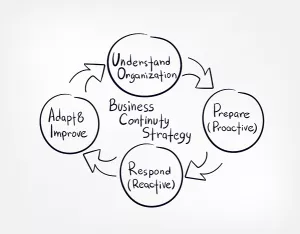If the last year has taught us anything, it’s that we never know what’s around the corner. Just look at a few of the events that have shaped the last year alone:
- A pandemic that’s taken nearly three million people while causing over 100K businesses to shut their doors.
- Social unrest across the United States leading to more than a billion dollars in damage.
- An unprecedented wildfire season that burned 10.3 million acres (compared to 4.7 million the year prior).
- Several high-profile, state-sponsored cyber-attacks affecting tens of thousands of businesses, intelligence agencies, and more.

Create a Business Continuity Plan
Business continuity planning requires you to take a comprehensive assessment of your business, as you consider everything that could possibly prevent you from continuing to operate if disaster strikes. Let’s look at the steps you should take as you craft your plan.
- Discuss continuity plan goals
Executives and key stakeholders should be involved in the planning phase along with department heads. Ideally, your plan should ensure that no matter what happens (fire, cyberattack, death of an executive, trouble with a vendor), your business can keep employees safe and your business running. So, if disaster strikes, how much business downtime can you afford? If equipment fails, how much data can you afford to lose? What actions must you take following a disaster and what are your objectives? Document these and move on to the next phase.
- Assign a team lead
Your plan is something your entire organization will need to understand and participate in. As such, it’s wise to assign a team leader in charge of gathering critical pieces of information, ensuring that the plan is documented, and working with various people and departments to establish appropriate protocols. Once complete, these people may also help disseminate the plan to ensure that the entire company understands it.
- Gather information
This is a big step that covers the following categories:
People
In terms of your employees, who does what, how do you contact them, and what is their role if something goes wrong? For vendors, who do you depend on and what will you fall back on if something goes wrong?
Equipment
What equipment does what? Can you diagram it and see clearly how it all works together? What is your disaster recovery plan for things like desktops, servers, and so on? Are you taking backups to prevent data loss? If equipment fails, do you have a recovery plan to reduce downtime?
Process
Do you have documented standard operating procedures (SOPs) for everything? Does each SOP include alternative processes or a way to adapt if something goes wrong? For instance, consider the COVID-19 pandemic. In order to ensure social distancing, healthcare providers changed their typical waiting room process by asking people to wait in their vehicles, where they’d check in via text or phone call. Be sure that your processes aren’t so rigid they can’t be adapted.
- Document your plan
At this point, you should have the info you need to document a plan. Though you may not be able to create a plan that covers every possible issue, you can at least create a plan that covers the most common occurrences. What happens if there’s a large disaster? What about a big data breach? What is the line of succession if something happens to an executive? What if your key vendor closes? Consider the most likely scenarios and document your plan for surviving them. - Test your plan
If you don’t test and refine your plan you can’t be sure it’ll succeed in an actual disaster. Schedule time to test various scenarios so you can be sure that what you’ve planned is actionable and functional. Things like fire and earthquake drills might be obvious, but it’s also smart to test backup and recovery plans to ensure that you can restore servers and other critical equipment in a timely manner.
Start Planning Now
There’s no time to waste. Each day we hear about another data breach. News of droughts in the west brings fears that wildfire season will start even earlier. There are many unforeseen trials still to come. Now is the time to craft a thorough and flexible plan for handling them.
If you’re wondering about the best way to maximize uptime for servers, desktops, and other essential systems, reach out to a StorageCraft sales engineer who can guide as you craft your business continuity plan.
You May Also Like
- Backup and Disaster Recovery Data Resilience
Introducing Arcserve 10000 Series Appliances: Rapid Deployment. Enhanced Security. Simplified Compliance.
December 10th, 2024 - Backup and Disaster Recovery Business Continuity Cloud Compliance Cybersecurity Data Protection Data Resilience Data Storage Ransomware
The Importance of Versatile Cloud Data Protection Support in a Multicloud World
December 3rd, 2024 - Backup and Disaster Recovery Business Continuity Cybersecurity
Tech Conversations - Beyond the Arc: Cyber Confidence for Business Leaders
December 2nd, 2024